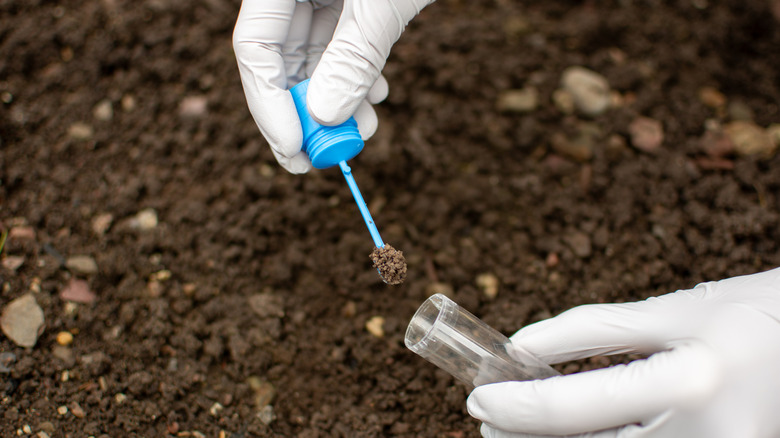The Common Soil Addition You May Want To Consider Using To Increase Acidity
Many popular landscape and fruit species like blueberries, rhododendrons, and azaleas grow best in moderately acidic soils. It is because low pH improves the availability of iron, manganese, and other nutrients. If you want to grow those colorful plants that thrive in a garden's acidic soil, but a soil test is showing you can't because the pH is too high, you might be looking for an additive that can remedy the problem — something that can help you decrease the pH of your garden soil, or in other words, increase the acidity of the soil. That is where aluminum sulfate and elemental sulfur can help.
They are both common options to make your soil more acidic. Why? Because they are widely available and used explicitly for acidifying soils in home gardens. However, aluminum sulfate is what takes the lead. It dissolves in the blink of an eye in the water. This allows it to lower the pH of your garden soil in a matter of just a few days. In contrast, elemental sulfur likes to take its time. It needs to be first be oxidized by soil bacteria to sulfuric acid, which isn't an immediate process.
However, keep in mind that the same properties that make aluminum sulfate a great choice, i.e., rapid action and high solubility, can also cause problems. Use too much, and your soil can turn overly acidic, even toxic, with runoff that might reach and pollute groundwater.
How aluminum sulfate acidifies soil and why it becomes toxic
When you put aluminum sulfate in the ground, it breaks apart. In moist soils, it releases aluminum and sulfate ions that then convert into aluminum hydroxide and sulphuric acid, lowering the soil pH. This is just a one-step chemical reaction, which happens quite fast. In contrast, sulfur takes time, as it must go through two steps. One biological and the other chemical. But this is where the problem starts. Despite its speedy action and high solubility, the amount of aluminum sulfate you need is quite large to achieve the same results as elemental sulfur.
Almost six times as much, to be precise. And this is where the problems begin. When you use aluminum sulfate to lower your soil's pH, it definitely works. However, it also adds aluminum to the soil at the same time, and at a pH lower than 5.5, it becomes soluble in the water. This increases its bioavailability to plants, which inhibits root growth.
If exposure continues, those high aluminum levels can become toxic and seriously harm or even kill the plants. Also, aluminum is not a nutrient plants actually need, but it can get in the way. Take, for instance, phosphorus. It is an essential plant nutrient, but high aluminum levels can block its uptake by the roots.
How to use aluminum sulfate safely to increase soil acidity
If you decide to use aluminum sulfate anyway, then you have to proceed with caution. Treat it as a precise tool rather than a general soil conditioner, and as always, start with a soil test. Fall is often the best time of year to start testing the quality of your soil, but no matter when you do it, a test will give you important information about your soil's pH and nutrient deficiencies. It will also help you decide how much aluminum sulfate you can safely use before it becomes toxic for your plants. Skip aluminum sulfate entirely on soils already near or below a pH of 5.5.
If the pH is okay, though, you can use about 1 pound of aluminum sulfate for every 10 square feet of the soil to lower your soil's pH by about 0.5. This shouldn't be a process you do all at once, however. As a general rule of thumb, you shouldn't exceed 20 pounds per 1,000 square feet or 1/5 pound per 10 square feet in a single application. If you retest and your soil's pH hasn't dropped enough, leave the area as-is and apply more aluminum sulfate next year. Lastly, reserve aluminum sulfate for ornamental beds and flowers. Avoid its general use in large landscape areas and always follow safety guidelines before using any chemical in your garden.


